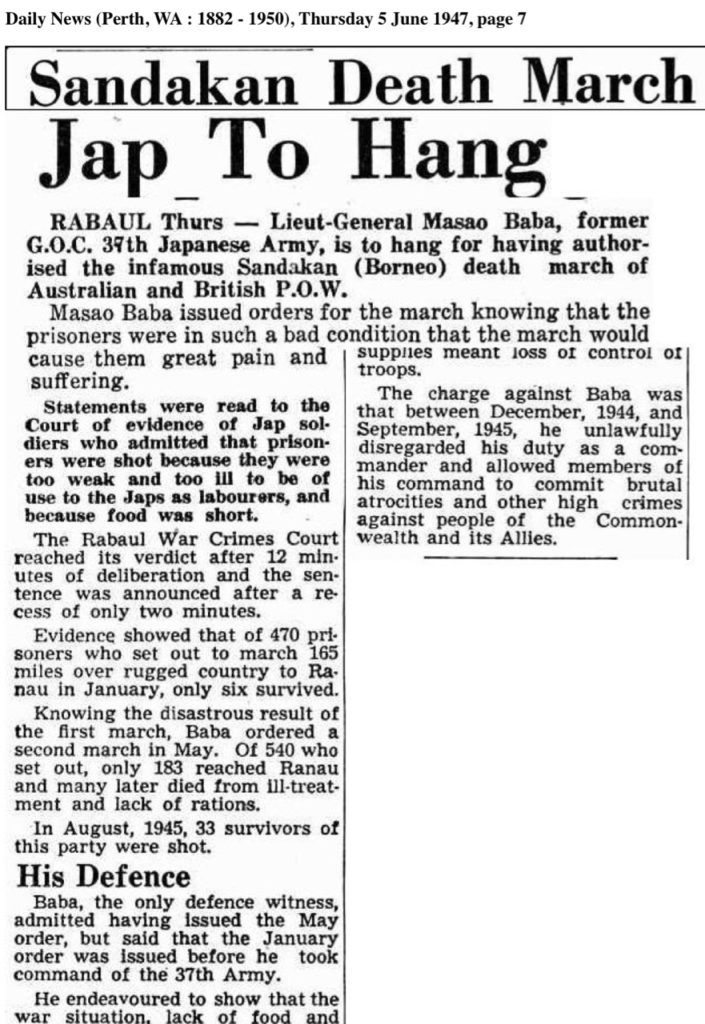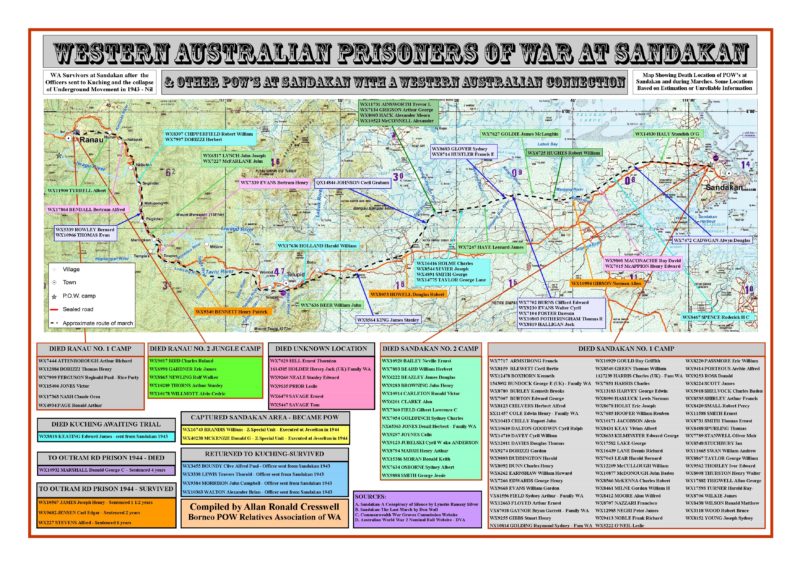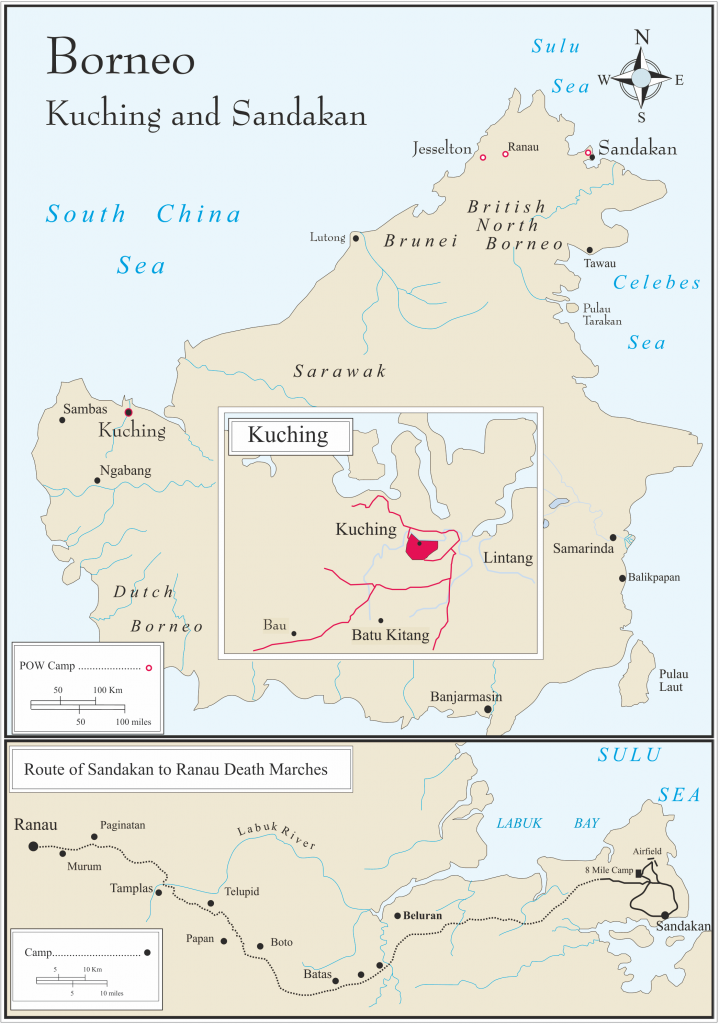Of 141 Western Australian’s who perished in Borneo, 71 were members of 2/4th Machine Gun Battalion, including NX73279 Cecil William Newman who was taken on Strength at Sydney on 9 January 1942.
In 1942 and 1943, Australian and British POWs who had been captured at Battle of Singapore 8-15th February 1942 were shipped to North Borneo to construct a military airstrip and prisoner-of-war camps at Sandakan, North Borneo (Sabah). As on Burma Railway the prisoners were forced to work at gunpoint, and were often beaten whilst also receiving very little food or medical attention. In August 1943, with the intention of controlling the enlisted men by removing any commanders, most officer prisoners were moved from Sandakan to Batu Lintang camp at Kuching. Conditions for the remaining prisoners deteriorated sharply following the officers’ removal. Any rations given were further reduced, and sick prisoners were also forced to work on the airstrip. After construction was completed the prisoners initially remained at the camp. At the end of December 1944, with only 1,900 prisoners still alive, the advancing Allies managed to successfully bomb and destroy the airfield. It was at this time with Allied landings anticipated, that camp commandant Captain Hoshijima Susumu decided to move the remaining prisoners westward into the mountains to the town of Ranau, a distance of approximately 260 kilometres (160 mi). He claimed that this was an order of Lt Gen Baba Masao, commanding officer of 37th Japanese Army.
The former military airstrip is now known as Sandakan Airport, which serves Sandakan town.
The first marches – The first phase of marches across wide marshland, dense jungle, and then up the eastern slope of Mount Kinabalu occurred between January and March 1945. The Japanese had selected 455 prisoners who were thought to be fit enough to carry baggage and supplies for the accompanying Japanese battalions relocating to the western coast. In several groups the POWs, all of whom were either malnourished or suffering serious illness, started the journey originally under the intention of reaching Jesselton (Kota Kinabalu). Although the route took nine days, they were given enough rations for only four days. As on the Bataan Death March, any POWs who were not fit enough or collapsed from exhaustion were either killed or left to die en route. Upon reaching Ranau, the survivors were ordered to construct a temporary camp. As one historian later commented: “Those who survived… were herded into insanitary and crowded huts to then die from dysentery. By 26 June, only five Australians and one British soldier were still alive.“
THE SECOND MARCH
The new Sandakan camp commander, Captain Takakuwa Takuo, ordered prisoners towards Ranau in groups of about fifty with accompanying Japanese guards. This second series of marches began on 29 May 1945 with approximately 536 prisoners. As with the First March, the Japanese deliberately delayed the groups’ departure times providing sufficient time so there could be no possibility of two groups collaborating together. The march lasted for twenty-six days, with prisoners even less fit than those in the first marches, POWs were provided fewer rations and were forced to forage for food.
Compound No. 1 of the Sandakan camp was destroyed in an attempt to erase any evidence of its existence. Only 183 prisoners managed to reach Ranau. Upon their arrival on 24 June 1945, participants of the second marches discovered that only six prisoners from the first series of marches during January were still alive.
THE FINAL MARCH
Approximately 250 men were left at Sandakan after the second march departed. Most prisoners were so ill that the Japanese initially intended to let them starve to death forcing many to scavenge in the surrounding forest for food. However, on 9 June 1945 it was decided to send another group of 75 men on a final march. The remaining men were so weak that none survived beyond 50 kilometres (31 mi). As each man collapsed from exhaustion, he was shot (or otherwise murdered) by a Japanese guard or guards. All remaining prisoners left at Sandakan who could not walk were either killed or died from a combination of starvation and sickness before the Japanese surrender on 15 August 1945.
(However it was not just POWs who suffered and died on the Marches – large numbers of Japanese soldiers also died of illness/starvation with some even turning to cannibalism in order to preserve their fighting effectiveness.)
The local population endured terrible starvation as the Japanese depleted their crops and supplies. Punishment was brutal and usually death slow to terrify the population. They were terrified of Japanese patrols and were unable to assist POWs.
Due to a combination of a lack of food and brutal treatment at the hands of the Japanese, there were only 38 prisoners left alive at Ranau by the end of July. All were too unwell and weak to do any work, and it was ordered that any remaining survivors should be shot. They were killed by the guards during August, possibly up to 12 days after the end of the war on 14 August. Furthermore, it has been estimated that 16% of the population of Sabah were killed during the three years of Japanese occupation, a reflection of the sheer brutality.
In total, only six Australian servicemen managed to escape. During the second marches, Gunner Owen Campbell and Bombardier Richard Braithwaite managed to escape into the jungle, where they were assisted by locals and eventually rescued by Allied units. During July, 1945 Private Nelson Short, Warrant Officer William Sticpewich, Private Keith Botterill and Lance Bombardier William Moxham managed to escape from Ranau and were also helped by the local people, who fed them and hid them from the Japanese until the end of the war. Of the six survivors, only four (Sticpewich, Botterill, Short, & Campbell) survived the lingering effects of their ordeal to give evidence at various war crimes trials in both Tokyo and Rabaul. The world was able to receive eyewitness accounts of the crimes and atrocities committed – unfortunately for the families of the soldiers, they were denied the truth and knowledge of their deaths. The Australian Government (and the British Government) decided the truth was too terrible and an official code of silence prevented even the media who attended the war trials to report on events.
1787 Total Number of Australians on Nominal Roll
641 Total Number British on Nominal Roll
6 Number who Survived
1381 Total number of POWs who died Sandakan
1047 Total number who died on Marches
It would be several decades before the World learnt of the terrible atrocities committed by the Japanese at Sandakan – Ranau.
The inability to learn what happened to their sons, brothers, husbands caused more pain for the families. Distressed families in particular fathers, went to their own graves never knowing details of where their loved one died, let alone how.
Captain Hoshijima was found guilty of war crimes and hanged on 6 April 1946. Capt Takakuwa and his second-in-charge, Capt Watanabe Genzo, were found guilty of causing the murders and massacres of prisoners-of-war and were hanged and shot on 6 April 1946 and 16 March 1946 respectively.
Above was Compiled by Allan Creswell, Borneo POW Relatives Assoc of WA.
Additional information has also been included by 2/4th MGB.
Following map created by Murray Ewen
Reflect on the men from Western Australia who perished in Borneo.







